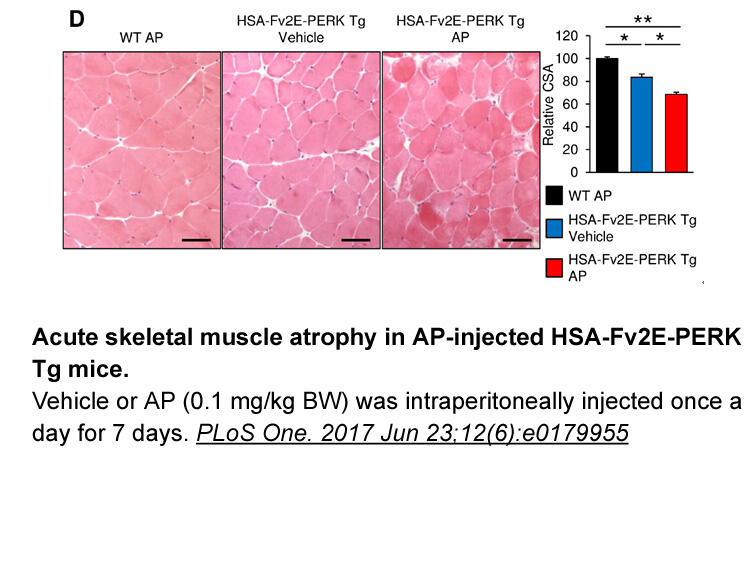Archives
We have recently reported a regulatory effect of
We have recently reported a regulatory effect of quercetin on the AChE activity in the brainstem during the demyelination and remyelination process [17]. It has also been observed that there is a protective effect on lipid peroxidation and worsening of motor functions caused by loss of myelin in the adenosine receptor antagonist [17]. Moreover, ethidium bromide (EB) has been used extensively in rats as a demyelinating model to assess endogenous remyelination [21] as well as oligodendrocyte and astrocyte loss, which are hallmarks of an EB lesion, whereas the axons remain unaffected [22]. It is important to note that motor deterioration is a major clinical manifestation of MS. In fact, the use of rats subjected to demyelination allows for the translation of morphologic and behavioral factors presented in MS and contributes to a better understanding as well as the development of new drugs for this disease.
This work was carried out based on our hypothesis that quercetin can protect Na+,K+-ATPase activity in the CNS, reestablish the peripheral cholinesterases activities, and reduce oxidative stress during demyelination events in rats. In addition, we also investigated Na+,K+-ATPase activity, an important enzyme present along the axons, in the encephalic structures of the brain.
Methods and materials
Results
Discussion
In the present study, we verified the protective effect of quercetin on peripheral cholinergic signaling enzymes and oxidative stress markers in the blood of rats during demyelination and remyelination periods. In addition, we also investigated the Na+,K+-ATPase activity, which is highly present in the axons of neurons and critical for neurotransmission in the nervous system. The experimental demyelination model induced by EB has been used to evaluate the events related to demyelination and remyelination because this toxic model simulates enzymatic, morphologic, and behavior alterations that can occur in diseases, which promote the destruction of myelin sheaths of neurons, such as MS [16], [44].
We found that demyelination in the pons led to a reduction in the Na+,K+-ATPase activ ity in both pons and cerebellum, and an increased activity of this enzyme in the pons in the remyelination period. After each depolarization, Na+,K+-ATPase rapidly promotes 3 Na+ ions to the extracellular medium and 2 K+ ions into the axoplasm in an energy-dependent manner [3]. Rapid repolarization permits the rapid and repetitive axonal firing, which is a necessary event for proper neuronal function [45], [46]. When the axons are demyelinated, the Nav+ channels diffuse away from the nodes [47]. This Nav+ channel redistribution increases the Na+ influx during impulse conductance, and a higher activity of the Na+,K+-ATPase is necessary to restore the concentration gradients. Thus, a decline in the activity of this enzyme directly compromises axonal impulse transmission and may be associated with motor worsening observed in rats in the demyelination phase [17]. Quercetin is involved in stopping the apoptotic process, promoting cell survival and differentiation and triggering other beneficial effects, such as decreasing oxidative stress [17], [30], [48]. However, ion channel modulation or activation/inhibition of ion pumps has not yet been investigated. Our results could indicate that quercetin has the capacity to regulate demyelination and remyelination processes by signaling myelin repair and possibly mitigate the effects of MS.
The measure of blood biomarkers might represent one of the important methods for evaluating the oxidative status of neuroinflammation and disease severity, especially in the early phase of MS [49]. The association of oxidative stress and inflammation in a close correlation with redox dysfunction in erythrocyte has been reported in some proinflammatory conditions [50]. During the demyelination phase, an increase in the AChE activity in lymphocyte and whole blood can be observed. Quercetin was able to restore the AChE activity in these tissues. However, in the remyelination phase, only the AChE activity of lymphocytes, not the whole blood, showed an increase, and quercetin prevented this effect. Based on this evidence, only AChE seems to play a role in the demyelination process when compared with BuChE.
ity in both pons and cerebellum, and an increased activity of this enzyme in the pons in the remyelination period. After each depolarization, Na+,K+-ATPase rapidly promotes 3 Na+ ions to the extracellular medium and 2 K+ ions into the axoplasm in an energy-dependent manner [3]. Rapid repolarization permits the rapid and repetitive axonal firing, which is a necessary event for proper neuronal function [45], [46]. When the axons are demyelinated, the Nav+ channels diffuse away from the nodes [47]. This Nav+ channel redistribution increases the Na+ influx during impulse conductance, and a higher activity of the Na+,K+-ATPase is necessary to restore the concentration gradients. Thus, a decline in the activity of this enzyme directly compromises axonal impulse transmission and may be associated with motor worsening observed in rats in the demyelination phase [17]. Quercetin is involved in stopping the apoptotic process, promoting cell survival and differentiation and triggering other beneficial effects, such as decreasing oxidative stress [17], [30], [48]. However, ion channel modulation or activation/inhibition of ion pumps has not yet been investigated. Our results could indicate that quercetin has the capacity to regulate demyelination and remyelination processes by signaling myelin repair and possibly mitigate the effects of MS.
The measure of blood biomarkers might represent one of the important methods for evaluating the oxidative status of neuroinflammation and disease severity, especially in the early phase of MS [49]. The association of oxidative stress and inflammation in a close correlation with redox dysfunction in erythrocyte has been reported in some proinflammatory conditions [50]. During the demyelination phase, an increase in the AChE activity in lymphocyte and whole blood can be observed. Quercetin was able to restore the AChE activity in these tissues. However, in the remyelination phase, only the AChE activity of lymphocytes, not the whole blood, showed an increase, and quercetin prevented this effect. Based on this evidence, only AChE seems to play a role in the demyelination process when compared with BuChE.